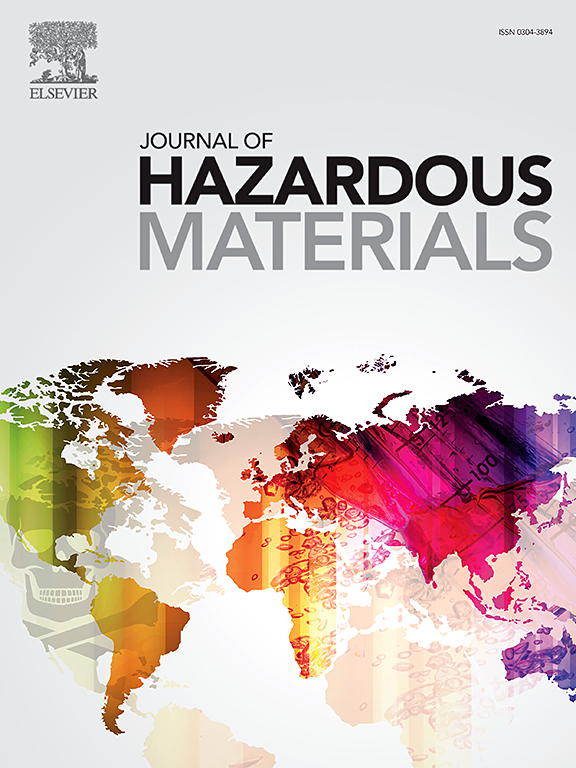Sulfidation of ZVI by mechanochemical synthesis: Lattice doping and enhanced reactivity
IF 11.3
1区 环境科学与生态学
Q1 ENGINEERING, ENVIRONMENTAL
引用次数: 0
Abstract
Sulfur doping into the crystalline lattice of zero-valent iron (ZVI) enhances its electronic properties and local structure, improving its efficacy for transforming environmental contaminants. This study demonstrates a novel high-energy ball milling approach to initiate mechanochemical reactions for precise sulfur doping into the Fe0 lattice, addressing the hazards posed by hexavalent chromium (Cr(VI)) and trichloroethylene (TCE), two priority pollutants known to threaten public health and ecosystems. Mechanochemically sulfidized ZVI (SZVI, 0.182 %–5.698 % sulfur) exhibited Cr(VI) and TCE removal rates up to 20 and 7 times higher, respectively, than SZVI prepared by conventional solution chemistry with aqueous Na2S, forming primarily surface-bound iron sulfides. By tuning milling time to control sulfur incorporation, removal capacities of 130.5 mg/g for Cr(VI) (S: 3.802 %) and 70.1 mg/g for TCE (S: 4.557 %) were achieved under environmentally relevant conditions mimicking groundwater matrices. Mechanical energy catalyzes in-situ iron sulfide (FeSx) ieformation through lattice expansion and atomic-scale Fe-S interpenetration, as confirmed by FeS and FeS2 crystalline phases, symmetric Fe-S bond vibrations, and rearrangement in the Fe coordination environment. These findings advance ZVI-based remediation strategies, mitigating risks from hazardous contaminants in environmental systems.

机械化学合成ZVI的硫化:晶格掺杂和增强反应性
将硫掺杂到零价铁(ZVI)晶格中,提高了其电子性能和局部结构,提高了其转化环境污染物的效率。本研究展示了一种新的高能球磨方法,用于启动机械化学反应,以精确地将硫掺杂到Fe0晶格中,解决六价铬(Cr(VI))和三氯乙烯(TCE)这两种已知威胁公共健康和生态系统的优先污染物所造成的危害。机械化学硫化ZVI (SZVI, 0.182 % -5.698 %硫)对Cr(VI)和TCE的去除率分别是Na2S水溶液化学法制备的SZVI的20倍和7倍,主要形成表面结合的铁硫化物。通过调整磨矿时间来控制硫的掺入,在模拟地下水基质的环境条件下,对Cr(VI) (S: 3.802 %)和TCE (S: 4.557 %)的去除率分别达到130.5 mg/g和70.1 mg/g。通过FeS和FeS2的晶相、对称的Fe- s键振动和铁配位环境中的重排,证实了机械能通过晶格膨胀和原子尺度的Fe- s互穿来催化原位硫化铁(FeSx)的形成。这些发现推进了基于zvi的修复策略,减轻了环境系统中有害污染物的风险。
本文章由计算机程序翻译,如有差异,请以英文原文为准。
求助全文
约1分钟内获得全文
求助全文
来源期刊

Journal of Hazardous Materials
工程技术-工程:环境
CiteScore
25.40
自引率
5.90%
发文量
3059
审稿时长
58 days
期刊介绍:
The Journal of Hazardous Materials serves as a global platform for promoting cutting-edge research in the field of Environmental Science and Engineering. Our publication features a wide range of articles, including full-length research papers, review articles, and perspectives, with the aim of enhancing our understanding of the dangers and risks associated with various materials concerning public health and the environment. It is important to note that the term "environmental contaminants" refers specifically to substances that pose hazardous effects through contamination, while excluding those that do not have such impacts on the environment or human health. Moreover, we emphasize the distinction between wastes and hazardous materials in order to provide further clarity on the scope of the journal. We have a keen interest in exploring specific compounds and microbial agents that have adverse effects on the environment.
 求助内容:
求助内容: 应助结果提醒方式:
应助结果提醒方式:


